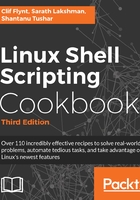
上QQ阅读APP看书,第一时间看更新
How to do it...
Let's take an example of the md5sum command we discussed in the previous recipes. This command performs complex computations, making it CPU-intensive. If we have more than one file that we want to generate a checksum for, we can run multiple instances of md5sum using a script like this:
#/bin/bash
#filename: generate_checksums.sh
PIDARRAY=()
for file in File1.iso File2.iso
do
md5sum $file &
PIDARRAY+=("$!")
done
wait ${PIDARRAY[@]}
When we run this, we get the following output:
$ ./generate_checksums.sh 330dcb53f253acdf76431cecca0fefe7 File1.iso bd1694a6fe6df12c3b8141dcffaf06e6 File2.iso
The output will be the same as running the following command:
md5sum File1.iso File2.iso
However, if the md5sum commands run simultaneously, you'll get the results quicker if you have a multi–core processor (you can verify this using the time command).